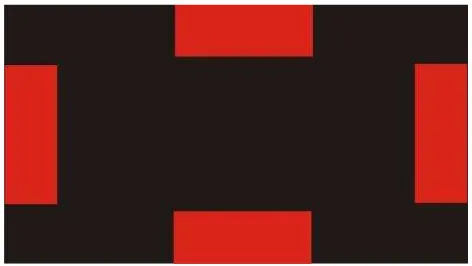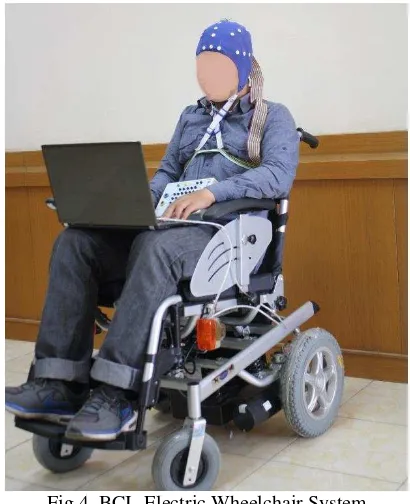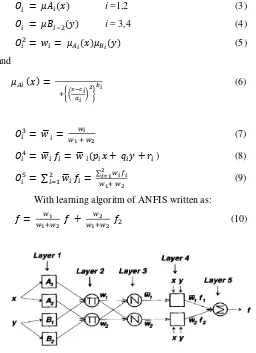An Application of Online ANFIS Classifier for
Wheelchair based Brain Computer Interface
Mardi Turnip, Abdi Dharma, Hendra H. S. Pasaribu,
and Mawaddah Harahap
Indonesian Institute of Sciences, Bandung, Indonesia
E-mail: [email protected]
Abstract— In this paper, an application of nonlinear adaptive filter on EEG-SSVEP extraction for brain-controlled wheelchair is proposed. We used Adaptive Network Fuzzy Interference System as classifier for EEG signals. We focus on steady-state paradigms using a periodic visual stimulus, which are increasingly being used in both brain-computer interface (BCI) and cognitive neuroscience researches In the experiment, four subjects with age about 25±1 years were tested. The experimental results in this work show that the implementation of the proposed method achieves a great statistical improvement in extracting peak amplitude features. The results from most participants could learn to extract the EEG-SSVEP wave with greater than 90% accuracy.
Keywords— Neural Networks; Nonlinear adaptife filter; Feature extraction; SSVEP; BCI; ANFIS;
I. INTRODUCTION
Utilization of Steady-state Visual Evoked Potential (SSVEP) in cognitive research in the world has been widely used [1]. With the method that is non-invasive system, and the extraction process of the signals, recording of EEG signals with SSVEP method can be utilized. Because of that benefit, SSVEP method widely used in brain or cognitive research. Among of them are used for a test of intelligence, BCI-speller, [4-8], audio speller [9], a lie detector test [10] and also used to control equipment such as computers, vehicles, and even robots [11].
For example, by far, utilization of EEG-SSVEP is for navigation, controlling of an objects or tools with multiple degrees of freedom (DoF), Multi manipulator, Prostethic Hand, and even a Humanoid Robot. In this study, we use of SSVEP for controlling the electric wheelchair. In the control is used as the LCD screen stimulus by using the flash, amounting to 4 parts with different frequencies.
Frequencies that used as stimulus has a range of between 6 Hz to 9 Hz. Because higher frequency than 40 Hz cannot be seen by the eyes, so that would make problems when detection in EEG- SSVEP method are used. So, after we get the signal, the next step, we did the processing of signal and signal feature extraction to get the results that we need. The result after classification, that we need use for controlling electric wheelchair. The problems of EEG processing and
classification (for obtaining maximum amplitude) are not standardized for clinical usage.
Fig 1.Visual Stimuli with EEG-SSVEP
In the digital signal processing especially EEG, a method Support Vector Machine (SVM) and Artificial Neural Network (ANN) has been used as a method of classification. While in this experiment, Adaptive Network Fuzzy Interference System (ANFIS) as a method of classification are proposed. A modular classification ANFIS algorithm based on two techniques in updating parameters is used. To fine-tune parameters that indicate membership functions (MFs), ANFIS uses gradient descent method. To identify the coefficients of each output equations, ANFIS uses the least-squares method. This system is called hybrid learning method (HLM) since it combines gradient descent and the least-squares methods [12]. In order to model complex nonlinear systems, the ANFIS model carries out input space partitioning that splits the input space into many local regions from which simple local models (linear functions or even adjustable coefficients) are employed [12]. The better the classification is, the better the application of any BCI system will be. The results from this experiment, show the implementation of EEG_SSVEP and ANFIS classifier for extracting and classifying the peak of amplitude which can use for different BCI application, i.e. for controlling electric wheelchair (figure 4).
978-1-4673-7408-8/15/$31.00©2015 IEEE
II. METHOD
A. Data Aquisition
In the experiment, four students (all males, age 25 ± 1 years, none of whom had any known neurological deficits) have participated. The subjects are asked to concentrate on directed stimulus on the screen while imagining a wheelchair moving in the direction of the flashed signal. A four-choice signal paradigm with differents frequencies (i.e., from 6 to 9 Hz for left, right, bottom, and top, respectively) is used to stimulate the four subjects. The EEG signals are recorded continuously using three electrodes (channels) at O1, O2, and Pz by following the 10-20 International System and digitized at a 500 Hz sampling rate (see Fig. 2).
Fig 2. EEG Recording
Each subject records four sessions to indicate four different directions. The subjects asked to look into each stimulus with duration 5 second, and then break 5 second before move to next stimulus. For the placement of electrodes shown at Figure 3.
Fig 3..Image of Electrodes that using in Experiment
B. Signal Processing
The results of raw EEG data that sourced from channel O1, O2 channel and channel PZ with a sampling rate of 500 Hz / sec would be processed. The raw data (Fig. 7) were first pre-processed using a sixth-order band-pass filter (BPF) with cut-off frequencies of 4 Hz and 30 Hz, respectively, see Fig. 8. This cut-off frequence were chosen according to the EEG-SSVEP frequence that implemented as stimulus. It can be seen that the RAW signals were corrupted by noises. The EEG’s raw data will be broken down as the sampling rate of the signal waveform, and to be analyzed in a shorter time interval.
Fig 4. BCI- Electric Wheelchair System
C. Clasification
An Adaptive Network Fuzzy Interference System (ANFIS) is used as classification method in this experiment. ANFIS is a system of decision-making method that combines Neural Network and Fuzzy. ANFIS has five layers feedforward neural netwok which can be seen as in fig. 5. Where, the first layer executes a fuzzification process, the second layer executes the fuzzy AND of the antecedent part of the fuzzy rules, the third layer normalizes the membership functions (MFs), the fourth layer executes the consequent part of the fuzzy rules, and finally the last layer computes the output of fuzzy system by summing up the outputs of layer fourth. In ANFIS there are several rules for the system. These rules are as follows:
Rule 1: If (x is A1) and (y is B1) then (f1 = p1x + q1y + r1) (1)
Rule 2: If (x is A2) and (y is B2) then (f2 = p2x + q2y + r2) (2)
where A1 and A1 are a fuzzy set in x; B1 and B2 in y. Ai and Bi
(i=1,2) are the fuzzy variable characterized by fuzzy membership functions and fi is a real constant value. The
outputs of this layer can be represented as:
i =1,2 (3)
i = 3,4 (4)
(5)
and
{( ) }
(6)
̅
(7)
̅ ̅ ) (8)
∑ ̅ ∑ (9)
With learning algoritm of ANFIS written as:
(10)
Fig 5.ANFIS architecture
The advantages of the Fuzzy Inference System (FIS) is all the advantages of a neural network can be obtained so that they can learn on their own and improve its ability. ANFIS with the ability of Adaptive Neural Network (ANN) is nonlinear model that is easy to use and understand compared to statistical methods that joined with Fuzzy System. Fuzzy is quite good in handling uncertainties and can inteprete relationship between i/o by producing rules.
Therefore, to increase the capability of Fuzzy and ANN, hybridization of ANN and fuzzy is usually implemented. Overall work of the system can be seen in the following block diagram:
Fig 6.Diagram Block System
III. EXPERIMENTAL RESULTS
Preparatory to an analysis of the features of maximum amplitude from EEG-SSVEP signals in online, actual signals were recorded in a thre-channels (O1, O2, and Pz) configuration. From fig. 6, shown the step process of the experiment. The raw EEG data were first pre-processed using a sixth-order band-pass filter (BPF) with cut-off frequencies of 4 Hz and 30 Hz. This cut-off frequence were chosen according to the EEG-SSVEP frequencies are about 6 to 14 Hz. From fig. 7 and 8, the comparison between RAW data signal and signal after filtered with band-pass filter is shown. To verify the accuracy of the extracted signals, each signals for all subject is classified using Adaptive Neuro-Fuzzy Inference System (ANFIS) method. The classification results with average about 90% accuracy is obtained.
Raw Data EEG
Wavelet Denoising
FFT
(Fast Fourier Transform)
Fig 7. RAW Data of EEG-SSVEP
Fig 8.Filtered EEG-SSVEP
Fig 9. Maximum Amplitude of Channel O1 (Subject 2)
And for the comparison of the results, brain map of subject 1 is displayed in the image below (before and after stimulus of the right direction displayed to subject).
Fig 10. Comparison of brain mapping Subject 1 Channels O1,O2, and PZ.
The results of ANFIS classification is done by comparing with the data train. We got the data train from In order to get the data error from 320 datas, got 6 datas with error (1.875%). So, the percentage of accuracy is about more than 90%.
Table 1. The frequencis of extracted maximum amplitude of subjects
No Stimulus
Frequencies (Hz)
Subject-1 Subject-2 Subject-3 Subject-4
1 Left 6,308690013 6,474708171 6,47470817 6,723735409
2 Top 9,463035019 9,130998703 9,1309987 9,047989624
3 Right 8,383916991 7,636835279 7,63683528 8,300907912
4 Bottom 8,217898833 8,383916991 8,38391699 8,051880674
5 Left 8,051880674 7,968871595 7,9688716 7,387808042
6 Top 9,214007782 9,629053178 9,62905318 9,047989624
7 Right 8,300907912 8,300907912 8,21789883 7,304798962
8 Bottom 8,300907912 8,217898833 8,21789883 8,300907912
IV. CONCLUSIONS
The ANFIS method applied as feature extraction step has the advantage of much less training time and provided significantly better classification accuracy. The application of the proposed online feature extraction method can identify the the frequence of the maximum amplitude (i.e., without down-sampling and averaging) with average 90% acuracy and it has been applied for BCI to run the controlled electric wheelchair. Similarly, the proposed method should be works and can become tool for controlling other applications.
ACKNOWLEDGMENT
This research was supported by the thematic program throughthe Bandung Technical Management Unit for InstrumentationDevelopment (Deputy for Scientific Services) and the flagshipprogram through the Research Center for Physics (Deputy forEngineering Sciences) funded by Indonesian Institute of Sciences, Indonesia.
REFERENCES
[1] F. Beverina, G. Palmas, S. Silvoni, F. Piccione, and S.Giove, "User adaptive BCIs: SSVEP and P300 basedinterfaces," PsychNol. J. vol. 1 , pp. 331 –54, 2003.
attention to stimulus location modulates the steady-state visual
evoked potential,” Neurobiology, vol. 93, pp. 4770-4774, 1996.
[3] M. M. Muller and S. A. Hillyard, “Effects of spatial
selective attention on the steadystate visual evoked potential in the 20-28 hz range,” Cognitive BrainResearch, vol. 6, pp. 249-26, 1997.
[4] R. Singla, A. Khosla, and R. Jha, “Influence of stimuli colour in SSVEP-based BCI wheelchair control using support
vector machines,” J Med. Eng. Technol., vol. 38(3), pp. 125-34, Feb. 2014.
[5] T. Kaufmann, A. Herweg, and A. Kübler, “Toward
braincomputer interface based wheelchair control utilizing tactually-evoked event-related potentials,” Journal ofNeuroEngineering and Rehabilitation, vol. 11:7, 2014
[6] D. Huang, D. Y. Fei, W. Jia, X. Chen, and O. Bai,
“Electroencephalography (EEG)-based brain-computer interface (BCI): a 2-D virtual wheelchair control based on event-related desynchronization/synchronization and state
control,” IEEE Trans Neural Syst Rehabil Eng., vol. 20(3), pp. 379-88, 2012.
[7] A. Turnip, K. S. Hong, and M. Y. Jeong, “Real-time feature extraction of P300 component using adaptive nonlinear
principal component analysis,” BioMedical Engineering
OnLine,” vol. 10(83), 2011.
[8] A. Turnip and K. S. Hong, “Classifying mental activities
from EEG-P300 signals using adaptive neural network,” Int. J. Innov. Comp. Inf. Control, vol. 8(7), 2012.
[9] A. Belitski, J. Farquhar, and P. Desain, “P300 audiovisual speller,” Journal of Neural Engineering, vol. 8(2), 025022, 2011.
[10] J. P. Rosenfeld, B. Cantwell, V. T. Nasman, V. Wojdac, S. Ivanov, and L. Mazzeri, “A modified, event-related potential-based guilty knowledge test,” Int. J. Neurosci., 42(1 -2), 157-161, 1988.
[11] M. Kh. Hazrati and A. Erfanian, “An online EEG-based brain-computer interface for controlling hand grasp using an adaptive probabilistic neural network,” Medical Engineering & Physics, vol. 32(7), pp. 730-739, 2010.
[12] S. Kim, Y. Kim, K. Sim, and H. Jeon, “On Developing an
Adaptive Neural-Fuzzy Control System,” Proceedings of IEEE/RSJ Conference on Intelligent Robots and Systems, Yokohama, Japan, pp. 950-957, 1993.
[13] P. Sajda, A. Gerson, R. Müller, B. Blankertz, and L.



